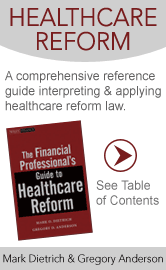 |
Issue #7-1 | December 13, 2012

Hospitals poised to topple off fiscal cliffIt’s “unlikely” that an agreement will be reached over sequestration of Medicare payments, so hospitals stand to lose more than $11 billion in 2013, according to a newly released outlook for the healthcare industry. Tax increases and spending cuts designed to slash the deficit will hit all companies in the healthcare industry. But for-profit hospitals and health systems may feel the brunt of the impact if Medicare payments are cut as part of the negotiations, according to the 2013 Outlook: U.S. Healthcare from Fitch Ratings, a major credit rating agency. Look out below: Starting in early 2013, the automatic budget cuts—or sequestration—of Medicare funding could result in a 2% drop in payments for providers. “Fitch thinks an agreement that avoids a 2% sequestration of Medicare payments and an 8% sequestration of NIH research funding is unlikely, and so expects sequestration will affect the healthcare industry, at least for a portion of 2013.” The analysis goes on to say that "an even bigger concern is the potential for reforms to the Medicare and Medicaid programs to reduce the size of the federal deficit." However, Democrats in Congress say they do not support those types of reforms. Big picture: Fitch is forecasting low, single-digit growth for most healthcare companies in 2013. Such factors as the aging population, high rates of chronic disease, and demand from emerging markets will help revenue numbers. However, potential lower payments from Medicare and Medicaid due to the Congressional budget crisis, referred to as the “fiscal cliff,” will weaken results. Several provisions of the Affordable Care Act (ACA) will impact the industry for the first time in 2013 as well, including value-based purchasing and the Hospital Readmission Reduction program, which went into effect October 1. These provisions could become a “headwind” to many providers. “Potential erosion of profitability and cash flow is a risk for this sector in 2013,” says the report. What to do: The best ways to respond to all of these known—and many unknown—factors is for hospitals to ramp up cost containment efforts and look for ways to strategically grow in existing and new markets. Healthcare CFOs a little more optimisticDespite uncertainty about the new healthcare landscape and the impending fiscal cliff, healthcare CFOs are slightly more confident about the health of their industry, but are less optimistic about the overall U.S. economy, reveals a new survey. Healthcare CFOs in the GE Mid-Market CFO Survey represent organizations with revenues of $117 million and an employee count of 820, on average. Data comparisons are to survey results from the first quarter of 2012 unless otherwise stated. Here are the key findings: Overall economy: Healthcare CFOs have shifted their expectations for the U.S. economy from growth to stable over the next 12 months. Over half (53%) expect the economy to remain the same, while 33% expect it to grow, a swing of 29 percentage points. Healthcare industry: Healthcare CFOs had the largest uptick in sentiment regarding the health of their own industry (5.8 versus 5.2, on a scale of 1 to 10). Healthcare is the only industry to increase expectations for industry growth over the next 12 months (38%, up from 26%). The overall average is 30%. However, their optimism is still low compared to other industries. Only the retail sector has a lower level of optimism about its industry. Revenues: Fewer healthcare CFOs expect their revenues to increase in 2012 versus the previous year (49% versus 56%). Profits: Almost three-quarters (72%) expect profits to remain the same or decrease this year versus last year. Long-term growth: Healthcare CFOs showed the greatest decrease in likelihood to downsize over the next one to three years, going from 23% in the first quarter to 12% today. Forty-six percent expect to be in a moderate growth phase, an increase of 18 percentage points. Hiring: Fewer expect to hire in the next 12 months (54% versus 74%).Additional financing: Over a third (35%) are considering additional financing over the next 12 months to support equipment needs. This is up from 26%. Plus, more are considering additional financing for working capital (28% versus 17% in the first quarter). No end in sight for physician shortageNew studies predict a growing shortage of physicians in the U.S. This is a crucial issue for hospitals because healthcare reform will increase the number of people with health insurance coverage, creating more demand for physicians. Projected demand: A new study published in the Annals of Family Medicine projects the number of primary care physicians needed in the U.S. in the wake of the Affordable Care Act. The total number of office visits to primary care physicians is projected to increase from 462 million in 2008 to 565 million in 2025. That will require nearly 52,000 additional primary care physicians by 2025. The key drivers are population growth, aging, and insurance expansion due to healthcare reform. The study determined that population growth will be the largest driver, accounting for 33,000 additional physicians, while 10,000 additional physicians will be needed to accommodate population aging. Insurance expansion will require more than 8,000 additional physicians, a 3% increase in the current workforce. Shortfall: Currently, there is a shortfall of 15,230 primary care physicians, according to data from the Association of American Medical Colleges. This number is almost certain to shoot up in 2014, which is when insurance expansion for about 30 million Americans will go into effect. What’s more, the shortage may increase to 130,000 by 2025, says the study. In addition to healthcare reform, other factors contributing to the future shortfall are: 1) an increase in physician visit rates for people over 45 years old (visit rates have been rising steadily over the past 30 years for this group); 2) younger physicians working fewer hours; 3) more physicians nearing retirement; 5) tepid growth in graduate medical school enrollment; and 6) perceived inadequate compensation for primary care physicians. What it means: For hospitals, the long-term effect of this is that the cost of hiring a physician will rise as the supply decreases in the face of increasing demand. Hospitals targeted in stepped-up GAO probes of Medicare fraudHospitals and medical facilities were the most frequent targets of civil cases involving Medicare fraud, reveals the Government Accountability Office (GAO). The agency will increase its scrutiny next year and stresses that much more still needs to be done. Enforcement actions: Kathleen King, director of health care for the GAO, recently gave testimony before the House Committee on Energy and Commerce's Subcommittee on Health. The GAO investigates civil and criminal cases involving Medicare fraud. She reported that hospitals made up 20% of the 2,339 civil fraud cases investigated in 2010, and medical facilities accounted for 18% of these cases. Of the total cases, almost half (47%) resulted in a judgment or settlement. The remaining cases resulted in no enforcement actions. King also said that the GAO is increasing its scrutiny of the Center for Medicare & Medicaid Services’ efforts to reduce Medicare fraud, stressing that there is still a lot of work to do in this regard. “We are investing significant resources in a body of work that assesses CMS efforts to refine and improve its fraud detection and prevention efforts,” said King. “Notably, we are assessing the effectiveness of different types of prepayment edits in Medicare and of CMS's oversight of its contractors in implementing those edits to help ensure that Medicare pays claims correctly the first time.” Policing efforts: The GAO is also examining how federal agencies are allocating funds from the Health Care Fraud and Abuse Control Program and whether the enforcement efforts have been effective. Plus, the GAO is investigating CMS's oversight and management of its Zone Program Integrity Contractors. These contractors are responsible for detecting and investigating potential fraud. More than $60 billion was lost to Medicare fraud in 2011, according to the U.S. Department of Health and Human Services in its semi-annual report to Congress. “Because of the amount of program funding at risk,” said King, “fraud will remain an inherent threat to Medicare, so continuing vigilance to reduce vulnerabilities will be necessary.” Hospitals and other organizations in the healthcare industry need to keep close tabs on these continuing efforts to combat Medicare fraud to avoid getting in the government’s crosshairs. Where to find hidden value in a physician practice Hospitals are acquiring physician practices at a frantic pace. To help ensure the financial success of this type of acquisition, it’s critical to look at areas where there may be untapped value. A new report reveals the top value drivers of a physician practice in this new environment, which points to opportunities to boost value after the deal is done. 1. Use of extenders. Physician extenders are nurse practitioners or physician assistants that can perform certain tasks in place of the physician. These individuals cost less than physicians, so the more they can be used, the more the opportunity for profit—and value. This is particularly important due to healthcare reform that will trigger an increase in insured individuals without the corresponding increase in primary physicians. Extenders can play a key role in handling the influx of new business. 2. Ancillary services. Some larger practices have invested in capital-intensive services to augment their practices, such as CT and MRI services. Are these services being used to capacity? If not, there’s an opportunity to boost the bottom line by increasing volume. And future profits will be even greater if physicians are compensated for personally performed services only and do not receive a cut of the extra business. 3. Payer mix. A practice receives payments from commercial and government insurers. Commercial reimbursement rates are higher than government rates and increase annually at a faster rate. A practice with more commercial payers in the mix—or the potential to shift to more commercial payers—will be more valuable, especially as healthcare reform eats away at government reimbursements. Also, there may be the potential to negotiate higher rates with the commercial insurers. Of course, this depends on the relative size and market strength of the hospital versus the insurer. 4. Overhead costs. Does the practice have high overhead costs when compared to industry norms? If so, this could be a chance to create value by reducing overhead to a more efficient level. Of course, you need to analyze this very carefully. There may be good reasons why overhead is higher than normal, so you can’t simply assume you can make wholesale cuts. Learn more: Now more than ever, hospital systems need to understand how physician practices function, both operationally and financially, and what ultimately drives their value. Physician Practices: Key Value Drivers in a Changing Environment examines these drivers as well as the critical questions to ask and analyses to perform to help ensure the success of a potential acquisition. |
|
||||||
1000 SW Broadway, Suite 1200, Portland, OR 97205
(503) 291-7963 | editor@bvhealthcarenews.com
www.BVResources.com/healthcare

